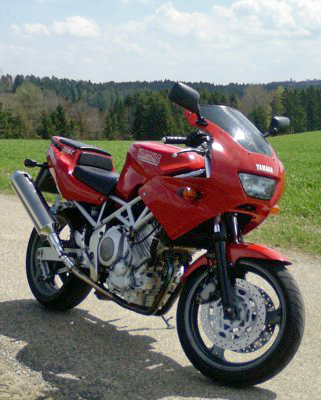 | |
| Manufacturer | Yamaha Motor Company |
|---|---|
| Also called | TRX, TRX850 |
| Production | 1995 - 1999 |
| Predecessor | Yamaha TDM 850 |
| Class | Sport bike |
| Engine | 850cc parallel twin |
| Transmission | 5 gear manual |
| Wheelbase | 1435 mm. |
| Dimensions | L 2070 mm. W 700 mm. |
| Seat height | 795 mm. |
| Weight | 190 kg. |
| Fuel capacity | 18 l. |
The Yamaha TRX is an 849 cc two-cylinder parallel twin motorcycle, manufactured by the Yamaha Motor Company of Japan to compete with the 900cc Ducati SuperSport V-twin. (The TRX's tubular trellis frame exchoes that of the Ducati). The TRX is derived from the Yamaha TDM 850, an all-rounder motorcycle with "supertrail" styling. The TRX first appeared in 1995 in Japan, and a slightly different version was available in Europe in 1996. The TRX sold poorly in Northern Europe and was overshadowed by bikes such as the Honda VTR1000, Suzuki TL1000S and Ducati 916, all of which have more power and more sophisticated suspension. In 1999 Yamaha stopped making the TRX, but the TDM, enlarged from 850cc to 900cc, is still in production.
The Yamaha dry sump engine produces 83.8 Nm of torque, and around 79bhp. Uniquely, the TRX oil tank is not remote, but is integral to the engine, sitting atop the gearbox. This design eradicates external oil lines and provides faster oil warm up. The 360-degree crank of the original TDM morphed into a 270-degree crank for both the TRX and later TDMs.
Compared to the TDM, the TRX is lighter, lower and sportier. Its front forks are conventional telescopics, while the rear suspension is a rising-rate monoshock unit. Many owners replace the original disc brake calipers with superior Yamaha "Blue-Spot" items. The stock silencers are heavy and tend to choke the output; so any TRX benefits from lightweight cans. The standard hard-compound Michelin Macadam tyres gave poor road adhesion. The TRX affords an excellent riding position position, albeit with a rock-hard rider's seat; but any pillion passenger fares badly. The pillion seat is hard and wafer-thin, the raised exhausts result in absurdly high pillion footpegs, and there is no grab rail.
"A cracking bike”
It should not be deduced from the above critique (nor from its slow sales) that the TRX was a poor motorcycle. Weighing only 190kg, the TRX handled well and was remarkably nimble for a large capacity motorcycle. Although one might have expected its 10-valve 850cc engine to produce more than 79bhp, this power output proved sufficient for real-world riding. The TRX has a loyal following of fans, many of whom would love to see a revised TRX back in production.
In a Motorcycle News readers' poll of the “Top Ten Big Twin Sports Bikes"(20 May 2009), the TRX came joint third, beaten only by the joint winners, the Ducati 916 & 748, with 90%. The TRX was rated at 88% (equal to the Ducati 996, Suzuki TL1000s & Honda SP-1). The TRX beat the Aprilia RSV1000 (86%), the Suzuki TL1000R (84%), the Honda Firestorm (82%) and the Aprilia Futura (80%). The rare MZ 1000S was not featured in the poll, perhaps a casualty of the present unpopularity of parallel-twin sports bikes. MCN declared that "Although ... it's a parallel twin and a touch on the bouncy side, the TRX is still a cracking bike. It's stable, handles neutrally and feels like a proper sports bike".
The 270-degree crank and the "Big-Bang Theory”
The ignition sequence in the TRX's 270-degree is known as the “big-bang firing order”, yielding a result resembling the sound and feel of a V-twin. In a parallel twin, a 270-crank allows a more regular firing pattern than a 180-crank, and less vibration than a 360-crank. But unlike the 180- & 360-cranks, a 270-crank engine never has both pistons stationary, so momentum is always maintained. Also, although the 270’s firing interval is not as uneven as the 180-crank (parallel-twin) or 90-degree (V-twin), which both fire 1-1-0-0, the 270-crank avoids being perfectly even; and this is said to allow better power delivery to the rear tyre by giving two fairly close power pulses followed by a "recovery gap" which supposedly helps the tyre resume full adhesion to the road.

0 comments:
Post a Comment